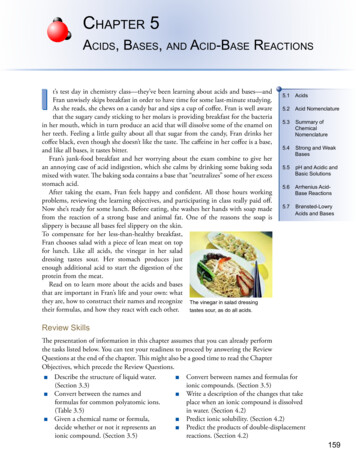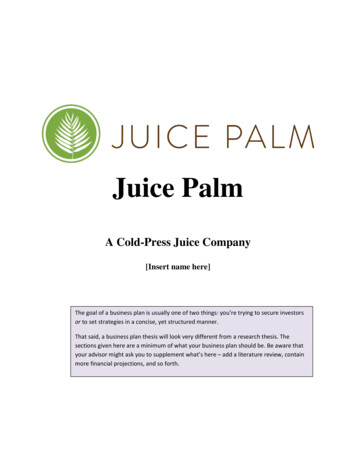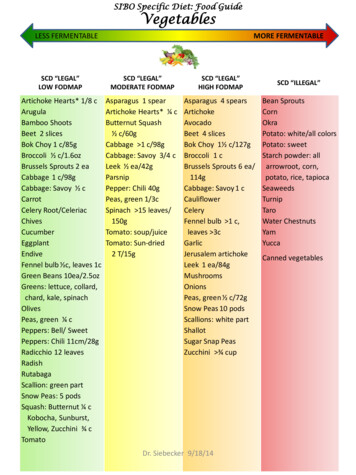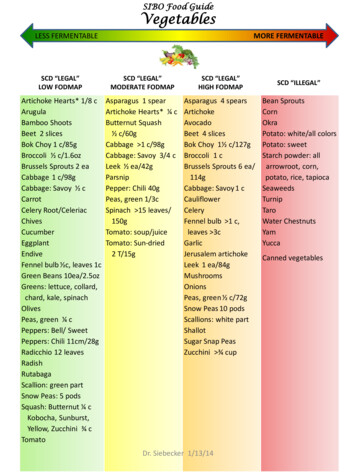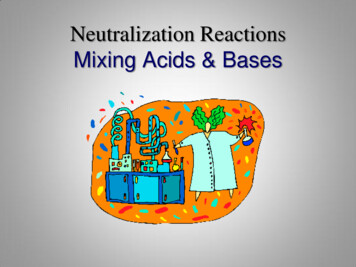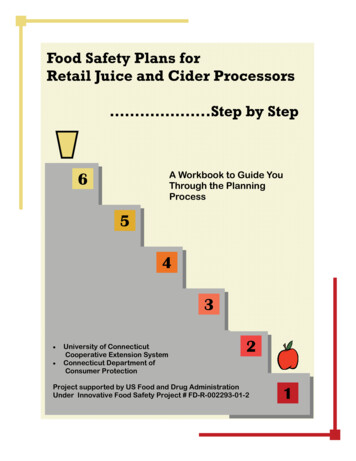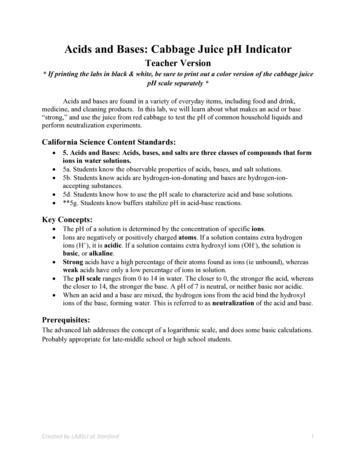
Transcription
Acids and Bases: Cabbage Juice pH IndicatorTeacher Version* If printing the labs in black & white, be sure to print out a color version of the cabbage juicepH scale separately *Acids and bases are found in a variety of everyday items, including food and drink,medicine, and cleaning products. In this lab, we will learn about what makes an acid or base“strong,” and use the juice from red cabbage to test the pH of common household liquids andperform neutralization experiments.California Science Content Standards: 5. Acids and Bases: Acids, bases, and salts are three classes of compounds that formions in water solutions.5a. Students know the observable properties of acids, bases, and salt solutions.5b. Students know acids are hydrogen-ion-donating and bases are hydrogen-ionaccepting substances.5d. Students know how to use the pH scale to characterize acid and base solutions.**5g. Students know buffers stabilize pH in acid-base reactions.Key Concepts: The pH of a solution is determined by the concentration of specific ions.Ions are negatively or positively charged atoms. If a solution contains extra hydrogenions (H ), it is acidic. If a solution contains extra hydroxyl ions (OH-), the solution isbasic, or alkaline.Strong acids have a high percentage of their atoms found as ions (ie unbound), whereasweak acids have only a low percentage of ions in solution.The pH scale ranges from 0 to 14 in water. The closer to 0, the stronger the acid, whereasthe closer to 14, the stronger the base. A pH of 7 is neutral, or neither basic nor acidic.When an acid and a base are mixed, the hydrogen ions from the acid bind the hydroxylions of the base, forming water. This is referred to as neutralization of the acid and base.Prerequisites:The advanced lab addresses the concept of a logarithmic scale, and does some basic calculations.Probably appropriate for late-middle school or high school students.Created by LABScI at Stanford1
Complete List of Materials: Colored & silver paper clipsPre-cut cabbageBlenderStrainerLarge containerMeasuring spoons7 clear plastic cups (depends on how many things you’re testing)Lemon juiceBaking sodaShampoo (preferably clear)Glass cleaner (with ammonia)Milk of MagnesiaWarhead Sour Spray or sour candy, such as Sour Patch KidsOther options include: vinegar (pH 2-3), apple juice (pH 4)Eye droppersIntroductory Mini-Lecture:Our lab today investigates acids and bases. Has anyone heard of an acid before? [Kids willprobably say acids “dissolve” things – comic book references, etc.] Strong acids are known to bedangerous because they can break down things like rocks or metals (or comic book villains!).What is an acid, though?These are two examples of acids. [Draw structures below on the board, leaving off the “weak”and “strong” at this point] The letters in this structure represent different chemical atoms. Whatletter (or atom) do these two acids have in common? [Answer: H] This “H” stands for hydrogen.While it’s stuck to the rest of the acid, it’s just an “H” atom. However, the special thing aboutacids is that they come apart when you put them in water – the “H” separates from the rest of themolecule. When that “H” comes off, it becomes an ion, meaning that it has a charge. In thiscase, it has a positive charge, so we write it as “H ”.Acetic Acid (Weak)Hydrochloric Acid (Strong)Acids are referred to as “strong” or “weak” depending on how many of the individual acidmolecules break up in water. For example, this molecule on the left (acetic acid – the acid foundin vinegar) is a weak acid [add the “weak” and “strong” labels to the diagrams] – if I put 100 ofthem in water, only 1 or 2 would actually let go of a hydrogen ion! Hydrochloric acid, though, isa strong acid. If I put 100 of them in water, all 100 would break apart. The same is true for bases,except that a base releases a hydroxyl ion instead of a hydrogen ion. These are “OH-” molecules,or an oxygen and a hydrogen stuck together that have a negative charge.*Created by LABScI at Stanford2
The number of hydrogen or hydroxyl ions matter, because they are very reactive – they can bindto other atoms. This includes the atoms in the water! Since water is made up of a hydrogen ionand a hydroxyl ion stuck together (making H2O), an acid will try and steal the OH- ion fromwater (leaving an extra H behind). Conversely, a base will try and steal the H ion from water(leaving an OH- behind). This will be important in part 2 of this lab.* Teacher Note: The students may ask why this oxygen and hydrogen don’t break up to form H ions. This isbecause oxygen by itself (just “O”) has a charge of -2. Since hydrogen has a charge of 1, you get an overall chargeof -1. Since chemical molecules are always trying to reach a neutral state, this oxygen is very unlikely to give up itshydrogen. Instead, it’s looking to steal another hydrogen ion from something else (also a characteristic of a base!).Part 1 – Modeling Acids and BasesIn this section, we will model what the differences are between strong acids or bases and weakacids or bases.Model of an acetic acidModel of a hydrochloric acid1. Make 5 paper clip models of acetic acid (a weak acid) and hydrochloric acid (a strongacid), using silver for the hydrogen atoms and two different colors for the rest of themolecule.2. Now imagine that you add each of your 5 acid molecules to water by putting them in thecorrect column below (feel free to rip this page out to be able to answer the questionswhile keeping the molecules in the “water”).STRONGCreated by LABScI at StanfordWEAK3
Q1. What happens to these acids in water? Model this with your paperclip molecules. How do aweak acid and a strong acid differ?The molecules dissociate, or break apart. In the weak acid, only a small fraction separate (1 ofthe 5). In a strong acid, however, all of them separate (5 of 5).Q2. If the acidity of a solution is based on the number of H ions (more ions more acidic),which of your two solutions would be more acidic?The strong acid solution would be more acidic, since it has more free hydrogen (H ) ions (5 vs1).Q3. Now lets compare solutions. Imagine that I put 10 “weak” acid molecules into a new glassof water. How many H ions will you have in each of these solutions?5 strong acid molecules: 5 H ions 10 weak acid molecules: 2 H ionsQ4. Which will be more acidic, the solution with 5 strong acids, or the one with 10 weak acids?Circle one. Why did you choose that solution?5 strong acid moleculesOR10 weak acid moleculesThe one with 5 strong acids has 5 H ions, while the one with 10 weak acids has only 2.Therefore the strong acid solution will still be more acidic.Q5. What if I add 50 weak acid molecules to water? How many H ions will each solution have?5 strong acid molecules: 550 weak acid molecules: 10Q6. Which solution will be more acidic? Why?5 strong acid moleculesOR50 weak acid moleculesA solution with 50 weak acid molecules will have 10 H ions, and will be more acidic than thestrong acid solution with 5 ions.Created by LABScI at Stanford4
Part 2 – Determining the pH of Household SubstancesStrong acids and bases are dangerous, and can really only be found in laboratories or chemicalplants. Weak acids and bases, however, are incredibly useful, and can be found all around us!But how do you test whether something is acidic or basic?You can rank how acidic or basic something is using a scale called the “pH scale.” As welearned in the last section, the number of hydrogen (H ) or hydroxyl (OH-) ions in a solutionaffects how acidic or basic it is. pH is measured using chemicals that change color when theybind to the extra hydrogen or hydroxyl ions in water. So, for example, the more acidic a solution,the more hydrogen ions there are, and the more the color will change! A solution of water, wherethe H and OH- ions are in balance, is called neutral, and it has a pH of 7. As you add more acid(and therefore more hydrogen ions), the pH goes down. A pH of 0 is the strongest an acid can bein water.Alternatively, the more of a base you put in water, the more hydroxyl ions there are (either fromthe base itself, or from the broken water molecules). This means that there are less H ions thanthere would be in a neutral (water) solution, and so you will have a pH higher than 7. As you getfarther from neutral, the solution gets more basic (and the number of OH- molecules increases).A pH of 14 is the strongest a base can be in water.Let’s measure the pH of some things that you can find in your house.Q7. Would you guess that the following substances are acidic, neutral, or basic? Circle youranswer.WaterAcidicNeutralBasicLemon JuiceAcidicNeutralBasicBaking dex (Ammonia)AcidicNeutralBasicMilk of MagnesiaAcidicNeutralBasicWarhead Sour Spray/Sour eated by LABScI at Stanford5
Making the pH Indicator (this can be done in advance):1. Put the red cabbage leaves into the blender with 800mL of water.2. Close the top and let it blend at high power for 30 seconds.3. Pour the mixture through a strainer into a large container. (This should provide you with600-800 ml of cabbage juice.)Testing pH:4. Pour 1 Tbsp of each individual liquid into its respective cup (except for baking soda).5. For baking soda, add 1 tsp of baking soda into 2 tsps water.6. For the sour candy, add a few drops of water to the candy to dissolve the sour coating.Swirl until dissolved and remove the candy. Use the dissolved coating to test pH.7. Pour 1Tbsp of cabbage juice into each of the cups, swirling gently.Q8. Write down what color each solution turns the cabbage juice, based on the following pHscale.Liquid:ColorPredicted pHActual pHWaterVioletVariable7Lemon JuiceRedVariable2Baking SodaBlueVariable8ShampooPurple / VioletVariable5.5Glass Cleaner (Ammonia)Blue-GreenVariable10Milk of MagnesiaBlue-GreenVariable10Warhead Spray/SourCandyRedVariable2VinegarRed / PurpleVariable3Now find out from your teacher what the actual pH of each of the substances is, and see howaccurate the cabbage juice indicator was!Created by LABScI at Stanford6
Q9. Categorize your results below:Very AcidicMildly AcidicNeutralMildly BasicVery BasicLemon JuiceShampooWaterBaking SodaGlass cleanerWarhead Spray/Sour CandyMilk ofMagnesiaVinegarADVANCED VERSION ONLYQSA10. All of the acids and bases in these solutions are “weak,” yet we get some pretty extremepH values. How is that possible? (Think about the questions in part 1)The more strongly acidic or basic solutions likely have a much higher concentration of the acidor base. As we mentioned before, 50 weak acid molecules in a solution will have a lower pH than10 weak acid molecules in solution (assuming you’re keeping the solution volume constant).Part 3 - NeutralizationSince acidic hydrogen ions (H ) have a positive charge, and basic hydroxyl ions (OH-) have anegative charge, they like to stick to each other when mixed together. When they do, they formH2O – do you remember what that is? [It’s water!] This is referred to as neutralization, since youare turning the acid and the base into water, which has a neutral pH.In order for neutralization to work, you need an equal number of H ions and OH- ions. If youhave extra H left over, the solution will still be acidic. If you have extra OH- ions left over, itwill still be basic. Only when the number of ions is equal can you be at a neutral pH.Created by LABScI at Stanford7
BASIC VERSION ONLYTo figure out how much of an acid or a base you will need to neutralize a solution, you can counthow many steps away from neutral a certain pH is. For example, pretend I had a solution at pH 4and a solution at pH 10. pH 4 is three steps away from neutral (7-4 3). pH 10 is also three stepsaway from neutral (10-7 3). Therefore I will need approximately an equal amount of the twosolutions in order to get to a neutral pH.QS10. Look back at the pH of lemon juice and of glass cleaner. What are the two pH’s? Howmany steps away from neutral (pH 7) are each of them?Lemon juice (pH 2) is five steps away, and glass cleaner (pH 10) is three steps awayADVANCED VERSION ONLYTo determine how much of an acid or a base you will need to neutralize a solution, you will needto figure out how many ions there are at a given pH. The pH scale is logarithmic, meaning thatone “step” in the scale (from 5 to 4, for example) reflects a difference of 10-times the number ofextra hydrogen ions. Similarly, a step from 8 to 9 has 10-times the number of extra hydroxylions. A pH of 7 has an equal number of hydrogen and hydroxyl ions.QSA11. Lemon juice has a pH of about 2, and glass cleaner a pH of about 10. How manyhydrogen ions would you predict in a solution at pH 2, assuming that a pH of 7 has 1ion? How many hydroxyl ions would you predict in a solution at pH 10, assuming that apH of 7 has 1 ion?A pH of 2 is 5 steps away from pH 7, so it has 10 5 ions, or 100,000 H . A pH of 10 is only 3steps away from pH 7, so it has 10 3 ions, or 1,000 OH-.QS11, QSA12. To get to a neutral pH, do you think you’ll need more lemon juice, more glasscleaner, or equal amounts of each? Why?You should need more glass cleaner, since you need an equal number of hydroxyl and hydrogenions in order to reach a neutral pH.Created by LABScI at Stanford8
1. Add 10 drops of water to 1 Tbsp of red cabbage juice in a clear cup.2. Add 10 drops of lemon juice to 1 Tbsp of red cabbage juice in a second cup.QS12, QSA13. How many drops of glass cleaner do you think it will take to get to a neutral pH?Answers will vary**Teacher note: For the advanced students, who just learned that a difference of 2 steps in thepH scale 100x more, they may predict that 100 x 10 drops 1,000 drops. In theory, this iscorrect, however because the lemon juice and glass cleaner aren’t “pure” acid and base, theydon’t behave exactly as predicted. The point to emphasize is that you require substantially moreglass cleaner, because it is closer to neutral.3. Now add 1 drop at a time of glass cleaner to the lemon juice, swirling carefully after eachdrop. Count how many drops it takes to turn the solution the same color as the water.4. Consult with others in your group to see how many drops they used, and enter thenumbers into the chart below.Number of Drops:Trial 1Trial 2Trial 3 100 100 100QS13, QSA14. Why does the solution turn from reddish to dark purple as you add the glasscleaner?Because the base in the glass cleaner (ammonia) is reacting with the hydrogen ions of the acid,removing them from solution (technically you are not actually making water in this case, sinceammonia is producing a slightly different type of ion, but it still binds to hydrogen and preventsit from floating around as a free ion)BASIC VERSION ONLYQS14. Did the number of drops match your prediction? If not, why do you think it was sodifferent?You almost certainly needed more. This is because as you get farther and farther from neutral,the space between the steps gets bigger and bigger. If it takes 10 drops to get from 6 to 7, then ittakes 100 drops to get from 5 to 7, and so on. Since lemon juice is two pH units farther fromneutral, you need a LOT more glass cleaner to make up that difference.Created by LABScI at Stanford9
ADVANCED VERSION ONLYAlthough the math isn’t very straight-forward for weak acids and bases (like we have here), youcan actually calculate the volume of strong acid needed to neutralize a strong base, and viceversa, using the formula below.Acid volume x Concentration of ions in acid Base volume x Concentration of ions in baseQSA15. If I have 1 volume of a strong acid at pH 5, how much of a strong base at pH 10 would Ineed to get to a neutral pH?A pH of 5 is 2 pH units away from 7, so it has 100 (10x10) hydrogen ions. A pH of 10 is 3 pHunits away from 7, so it has 1,000 (10x10x10) hydroxyl ions. You need an equal number of H and OH- to reach a neutral pH. That is why the two sides of the equation are set equal to eachother.1 x 100 ? x 1,000100 ? x 1,000100 / 1,000 ?1/10 ?Therefore, you need 1/10 volume of a strong base at pH 10 to neutralize 1 volume of a strongacid at pH 5Concept Questions:QS15, QSA16. Look at the list of things which have very acidic pH’s. What do these substanceshave in common? Can you think of other foods that probably also have acidic pH’s?They are all very SOUR to eat! Orange juice, grapefruit juice, and apple juice all haveacidic pH’s.** Teacher note: The reason that acids taste sour is the same as the reason they are acids– an excess of H ions! “Sour tastes are evoked by all acids in dilute solutions.Apparently, it is the hydrogen ion that activates taste receptors and leads to a sensation ofsourness.” ated by LABScI at Stanford10
QS16, QSA17. Fats and oils (like butter, vegetable oil, or even the oil on your skin!) can reactwith the OH- ions in bases and feel “slippery” or “soapy.” Can you think of instanceswhere that property would be useful? What kinds of things do you think basic productswould be useful for (besides neutralizing acids)?Cleaning supplies (including glass cleaner!) are often basic for this reason – they aregood at lifting oil and grease off of surfaces.** Teacher note: Have the students touch the glass cleaner and rub it between theirfingers – it feels slippery! Compare to the lemon juice, or just water.QS17, QSA18. Stomach acid has a pH of about 2. Normally the stomach protects itself byproducing a slippery substance that’s resistant to the acid, but sometimes it breaks down.What do you think happens? Do you know what this is called? How could you reduce theamount of acid (think of things that we tested!)?The acid can break down the stomach wall, which leads to ulcers. Excess acid can beneutralized by basic compounds, like Milk of Magnesia (which is commonly used forstomachaches).** Teacher note: Ulcers are actually the result of a combination of stomach acid and abacterial infection. The bacterial component was dismissed by doctors initially, but theresearcher who discovered it proved them wrong by drinking a beaker of the bacteriahimself, giving himself ulcers. Now that’s dedication to -drank-broth-gave-ulcer-solved-medicalmysteryQS18, QSA19. What is acid rain? Why do you think it’s bad for oceans, rivers, lakes, and othernatural environments?Air pollution from cars and factories gets mixed into rain clouds, making water withsmall amounts of sulfuric and nitric acid in it. When it falls back to the ground as rain,fog, or snow, the acid can change the pH of the water on the ground, which can kill fishand plants which are sensitive to this change in pH.Created by LABScI at Stanford11
probably say acids “dissolve” things – comic book references, etc.] Strong acids are known to be dangerous because they can break down things like rocks or metals (or comic book villains!). What is an acid, though? These are two examples of acids. [D
